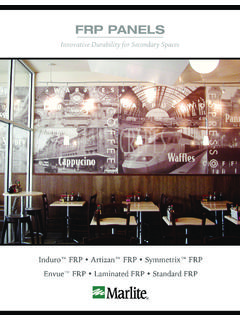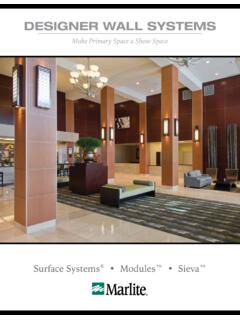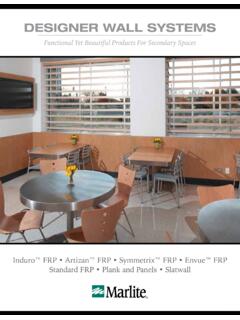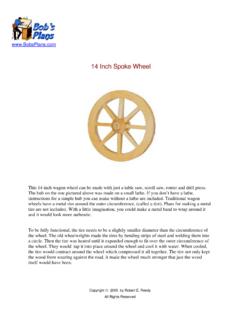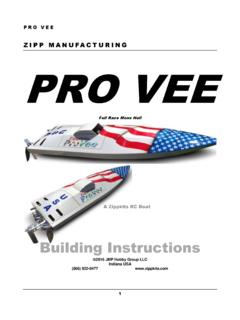Transcription of Installation Instructions - Marlite
1 Please Read Disclaimers:PLEASE READ ALL Instructions BEFORE BEGINNING INSTALLATIONT hese guidelines are provided in good faith to help prevent any problems caused by common errors in Installation . The manufacturer and/or distributor of this product shall not be held responsible for Installation actions taken or not taken. There are many details of Installation that are assumed to be general construction knowledge to experienced installers; which are not included in these Instructions . These Installation guidelines are intended to be strictly recommendations and are NOT to serve as a step-by-step, fail-safe Installation checklist. Selection of an experienced installer is the sole responsibility of the project owner and architect. Marlite , Inc. does not accept any responsibility for job failure resulting from or associated with improper site environmental InstructionsEffective Date: 1/15/162 Form No. FR32-01161 Uses & Applications:Laminated FRP panels with factory bonded substrates of wood, drywall, extruded foam or gypsum may be applied to wood or metal studs (proper gauge studs must be used for panel selected), furring strips, solid walls, ceiling joists are used as dividers.
2 Install a vapor barrier behind panel when installing in high moisture areas or use panels with factory applied vapor barrier. Proper selection of substrate is also required in high moisture areas in both interior and exterior applications. Note: Due to the nature of wood components parts used in the fabrication of Laminated FRP, some panels may have moderate bowing prior to Instructions :When cutting or drilling, always wear protective glasses or goggles and a face mask which covers the face and mouth. Itching due to fibers may be avoided by the use of barriercreams on exposed skin Needed: Power saws with carbide tipped saw blades Power drill with carbide bits PencilMaterials Needed: Laminated FRP panels Non-abrasive cleaner, soap and water, mineral spirits, for use in clean-up Rags Personal protection equipment (goggles & mask) Tape measure Saw horses Painter s tape Plywood larger than panels Ladders or scaffoldingStorage and PreparationAll Laminated FRP panels should be stored indoors in a dry area.
3 Do not store panels outdoors. Panels should be unwrapped and removed from skid and stacked on a flat, dry surface. Do not stand panels on edge or stack on fresh concrete floor or any other surface that emits moisture. Panel should be acclimated to temperature and humidity of space for at least 24 hours prior to Installation . Ideally, the room temperature and humidity during acclimation and Installation should be the same as the final operation conditions. Optimum storage conditions are 60 F (16 C) to 75 F (24 C) and 35% to 55% relative No. FR32-01161 Expansion & Contraction Laminated FRP panels will expand and contract. Always allow 1/8 gap at ceiling, base and gap between panels. If face mounted moldings (T-Bar, Batten, 2-Piece Division bar, ) allow 1/8 gap between panels (see diagram). Allow more space for expansion and contraction of panels longer than 8 and in area(s) where high fluctuation in temperature and humidity occur and when installing around pipes, conduits, electrical outlets, etcMolding & SealantsUse of moldings and silicone sealant with panels having appropriate substrates is recommended to achieve a moisture resistant Installation .
4 Cut molding to size and place silicone sealant into channel of molding during Installation . Place molding on panel before fastening and place small amount of silicone into hold before fastening, if required see below high moisture and frequent wash down area(s), silicone should be placed between molding and floor to prevent moisture from penetrating back of panel substrate. If no moldings are used, silicone sealant should be placed in gaps at floor, ceiling and between panels for moisture resistant Installation . Remove excess silicone during Installation or trim off silicone after it has : Failure to use moldings and sealant may cause panel deterioration. In high moisture areas or in standing water, edge swelling and moisture absorption by substrate will occur if appropriate sealants are not used properly. Install a vapor barrier behind panel Installation in high moisture areas or use panel with a factory applied vapor barrier. Proper selection of substrate is also required in high moisture areas.
5 This requirement is necessary for either interior or exterior No. FR32-01161 Fasteners All panels should be installed with non-corroding fasteners. Plastic pin rivets, chrome pin rivets, one piece nylon rivets, stainless nails, one stepper fasteners or screws are recommended. See below. Fasteners should be installed to fit snugly but should not be over-tightened. Always select proper fasteners for Installation . Plastic pin rivet fastens panel to wood, metal, drywall, concrete, insulation materials, etc. See diagram below: Note: If pin in rivet does not drive flush when fastening into solid materials and applications where expansion may be restricted, larger hole is required, use .261 - G bit. Chrome pin rivet has high shear strength but should be used in low moisture areas. Installation is the same as plastic pin rivet piece-nylon rivet fastens panels to any wood substrate or wood stud. See diagram below:5 Form No. FR32-01161 AdhesivesThe use of adhesive when installing panels is recommended along with fasteners.
6 titebond adhesives are recommended. For best Installation , adhesive should be used on studs in conjunction with fasteners when installing Laminated FRP panel. See diagram below:Fastener Layout 1. Pre-Fit each panel before fastening and cut panel if required to center on studs for proper fastening. 2. Apply vapor barrier behind panel Installation if required. Always use vapor barrier in high moisture areas. 3. Stud walls 16 -24 on center (o/c) use minimum 3/8 panel substrate. Ceiling joists 16 o/c use minimum 3/8 panel substrate; 24 o/c joists use minimum 1/2 -5/8 panel substrate. 4. Fastener frequency may vary with thickness of panel substrate. 5. On wood studs 16 o/c use stainless nails on edges every 8 o/c staggered on opposite panel edges. On center studs use plastic rivets every 24 o/c. For 24 o/c studs refer to fastening pattern diagram. 6. On metal studs 16 o/c use stainless screws on edges every 8 o/c staggered on opposite panel edges.
7 On center studs use plastic pin rivet every 24 o/c. For 24 o/c studs see diagram B. 7. If studs run horizontal, plastic or other types of fasteners may be used for complete Installation of panels. Fastener frequency same as in No. 5 or 6. See diagram A. 8. If only plastic fasteners are used for Installation of panels, fasteners should be placed at 12 o/c on edges and 16 o/c on center studs. 9. Some types of panels may be compatible for commercial installations using fasteners on edges (8 o/c) and adhesive on center stud(s). The results in a panel Installation with no visible fasteners. See diagram A. 10. Stud walls must be supported on opposite side of panel Installation and proper gauge stud must be used for panel selected, prevent deflection on wall system. Note: If panel deflects from center stud(s) after this type of Installation , fasteners will be required on center stud(s). The 1/8 edge separation rule may make it necessary to trim panel width or length occasionally as Installation progresses along a long wall with support members evenly spaced at 16 or 24.
8 6 Form No. FR32-01161 Mechanical Fastening PatternTop View of Panel InstallationSolid Wall Installation Diagram A7 Form No. FR32-01161 Metal Stud InstallationDiagram BInstallation Reminders 1. Follow safety and fire guidelines during Installation and use of panels. Compliance with local building codes is recommended. 2. First panel installed should be set true with plumb line. Check plumb line during Installation . 3. Pre-condition panels prior to Installation and allow for expansion and contraction during Installation . 4. Use moldings, silicone, fasteners, and adhesive with panels for best Installation . 5. Remove excess silicone during Installation or trim after silicone is cured. 6. Place molding on panels, if required before fastening panels ( CAP, ISC, OSC, etc.). 7. Cut moldings as needed. For example, division bar may need to be cut in accommodate a ceiling or base cove. 8. Cut panels, if required, for proper Installation .
9 9. Use hold-down clips if panels are used in a suspended ceiling. 10. Span studs or joists only with proper thickness of panel. 11. Clean panels, if required, after Installation . Cleaning InstructionsLaminated FRP panels are designed for minimum care and maintenance. When cleaning panels they should be washed with a light detergent. Panels may also be cleaning with steam, high pressure sprayers or soap and water. A 5% or 10% Tri Sodium Phosphate water solutions may also be used to clean panels. Rinse thoroughly after applying. Hard water deposits may be cleaned with a 10% solution of Acetic Acid in cold water. Rinse thoroughly after applying. It is strongly recommended not to use abrasive cleaners when cleaning panels. Adhesive can be removed from panels surface by using mineral spirits or equivalent solvent based cleaners. Note: Laminated FRP and components made of aluminum, polystyrene foam, vinyl and wood may be combustible and accordingly should be used in compliance with local codes and insurance regulations.
10 Effective Date: 1/15/161 Marlite Drive, Dover, OH No. FR32-01161

